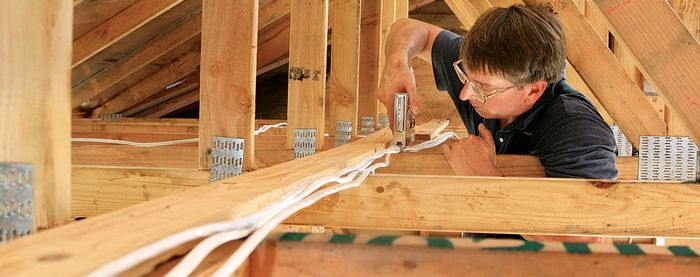Adding an Electrical Outlet to an Existing Run
Splicing a new receptacle in the middle of a run is simple.
Whenever you work with electricity, whether it’s a simple project or not, it’s best to know exactly what you’re doing before you start. That said, adding an electrical outlet isn’t that complicated. If you have an existing run, it won’t take a lot of your time. Furthermore, it’s safer to add an electrical outlet than it is to pack a store-bought power strip. Power strips can increase the risk of fires if not used correctly, especially if you have multiple high-intensity electronics attached to them.
Here we have an ideal situation—the drywall on one side of the wall has been removed and the wiring is exposed. But, save for installing a new electrical box, the process is largely the same (check out “How to Install an ‘Old-Work’ Electrical Box” to see how to install a new box when the drywall is intact).
To start, turn off the power to the existing outlet at the breaker panel, and test to ensure it’s off.
Then, remove the outlet and detach the wires.
Install the box for the new outlet, remove the “incoming” wires from the old box, and run them into the new one.
Then, cut a new length of the same-gauge cable to run between the new outlet and the old and feed it to the boxes, leaving about 8 in. of new cable in each box.
The cable needs to be secured to the studs, typically with wire staples, within 12 in. boxes that include cable clamps, or within 8 in. of boxes without cable clamps. When adding a new outlet without removing the drywall, there’s no requirement to secure the new cable to the studs.
To wire the new box, splice the wires from the new cable onto the old, along with pigtails that will connect to the new device. It’s best practice to cut the old exposed copper off the old wires and strip a fresh length to attach to the terminals.
Once the wires are connected (bare copper to the green screw, white to any silver screw, and black to any gold screw), fasten the receptacle, and repeat the splicing and connection process in the old box.
To finish, turn the breaker on and test both outlets to make sure everything is wired correctly.
More on Electrical:
Four Worry-Free Wiring Repairs – For nonelectricians, wiring repairs can be dreaded tasks. With the help of electrician Brian Walo, however, even beginners can consider tackling a few basic wiring repairs. Walo cautions that working with electricity can be dangerous and that it is important to be patient and to follow a few simple rules.
How to Install an Electrical Subpanel – To install a subpanel, an electrician shows how to pull the cables to the panel, or load center. He then works step by step through landing the grounds, the subfeed, and the neutrals, before installing the breakers and landing the hots. A series of photos shows the systematic process.
How to Wire a Switch Box – For this “Building Skills” article, veteran electrician Brian Walo describes how to wire a switch box. After stressing the importance of neatness and logic in the wiring process, Walo goes step-by-step, starting with running and labeling cables, and then bringing cables into the box.
How to Wire an Instagram-Worthy Electrical Subpanel – Neatness counts, both for impressing clients and for future service.
Master Carpenter: How to Wire a Bathroom – In this video series, electrician Cliff Popejoy explains how to run the rough electrical wiring for a bathroom. He’ll explain the necessary procedures for attaching outlet, switch and fixture boxes, tricks for running and stapling cable and last, how to prepare the boxes. Learn how to wire a bathroom here.






View Comments
Per NEC 334.30 Runs of Non Metallic cable (Romex) must be supported at least every 54 inches. They also must be secured within 12 inches of an electrical box that includes a cable clamp or within 8 inches of a box or enclosure without a cable clamp. Keep in mind that "support" does not always mean fastening the cable to framing. For example, with a typical cable installation inside a framed wall, the cable passes through holes drilled into the wall studs for most of its horizontal run. When the cable approaches an electrical box, it makes a turn to run up or down the side of the stud toward the box and is fastened (usually with a cable staple) to the side of the stud within 8 inches for boxes without a clamp or 12 inches for boxes with a clamp as required by NEC.
In your video, most of the cable is supported by the framing but is not fastened to the framing which is acceptable. Fastening the cable to the stud prior to entering the outlet box also needs to occur.
OK for new installations but what about existing ones with walls sealed both sides with sheetrock? A particularly difficult situation is faced by those with sprayed-in foam insulation. How do you blind-run wires through that stuff without cutting open walls and making a mess?